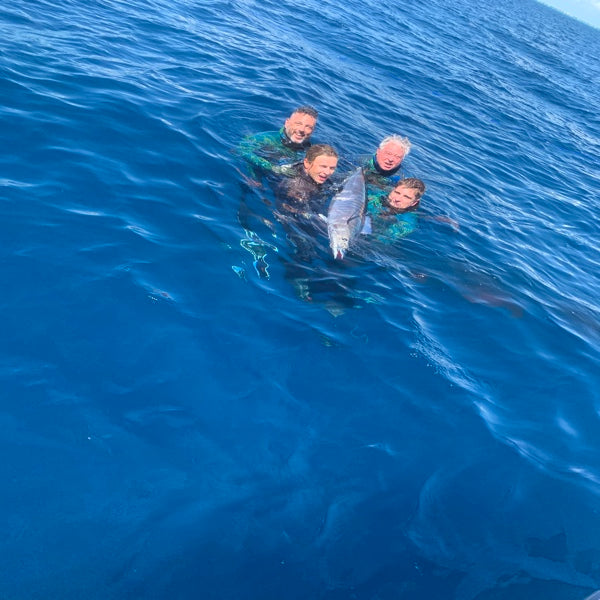
Bluewater Spearfishing Basics - What You Need to Know
Bluewater Spearfishing Basics
Bluewater spearfishing is challenging because it tests your patience; it is simultaneously the most boring and exciting spearfishing there is. Bluewater spearfishing requires its own set of special equipment, skills, and spots.
Mental Fortitude
Bluewater spearfishing is challenging because the fish tend to be elusive and difficult to pin down. Pelagic species are highly migratory, live in deep water, and are fast opportunistic predators. In order to target these species, you have to have incredible patience while drifting through infinitely deep, blue water. Typically, you spend eight to ten hours a day drifting over structure you will never see from the surface, hoping your boat driver dropped you on the right drift. If you are lucky you will have a few seconds of excitement just to see your target species. If you hit the jackpot, those seconds of excitement are followed by either a few minutes or several hours of absolute insanity as you attempt to land a fish of a lifetime.
Bluewater Equipment
Spearguns
The first difference between bluewater spearfishing and reef spearfishing is a larger speargun. Many pelagic species are wary of predation, and simply won’t get close enough to hunt with shorter spearguns. Bluewater spearguns tend to be both longer and wider. They are wider because they need the additional mass to compensate for the recoil of additional bands and larger spear shafts, and they are longer because they need more length for band stretch. The shaft is also different. A shaft used with the Bluewater gun will most likely require a slip-tip to allow the fish to fight without tearing a hole in itself. The reason a slip tip works is because it prevents the fish from using the shaft's weight and drag as leverage to tear a hole through its own flesh as it fights.
Floats and Floatlines
After securing a gun and shaft, you might want to look into a float and floatline setup. The type of float and floatline will be dependent on the fish you're targeting and your own dive ability. The deeper of a diver you are, the longer you can make your floatline. Larger fish will need multiple or larger floats as well a bungees to connect them. Smaller or more delicate fish will need smaller floats to prevent too much back pressure causing the slip-tip to pull out or tear out. For a more detailed explanation on choosing the right float and floatline, check out our articles on floatlines.
Bluewater Spearfishing Rigging and Accessories
You also have lots of choices between types of rigging and accessories that can help you land your fish a bit easier. Most bluewater spearos have adopted a breakaway setup to allow them to keep their speargun with them and to streamline their hunting. Instead of clipping the floatline directly to their guns, divers now hace the floatline connected to the shaft but not the gun so that when a fish is shot they can bring the gun to the surface while the shaft and floatline "break away" with the fish.
One of the accessories that comes in handy to bring fish into shooting range on your drifts is a flasher. A flasher is some type of shiny object or collection of objects designed to look like bait fish. The same infinite blue that makes bluewater fishing boring for long stretches also makes flashers very attractive to fish that you're hunting. They see nothing for blue but so long, which allows a shiny flasher to catch their attention. Because pelagic species are usually highly opportunistic predatory fish, they often come in to check out potential feeding opportunities. A group of divers may try several flasher rigs (rigs designed to mimic entire schools of bait) within a group using flasher floats set to depth, as well as throw flashers to target specific fish as they come in. Check out this video of our throw flashers doing the job.
An often underrated pice of equipment is the floatline clutch. Large fish often will make multiple runs as you start to pull them in. A floatline clutch helps you keep the progress you have made against your fish.
Bluewater Spearfishing Techniques
Diving as a buddy group is critically important in all diving from a safety perspective. That is never more true than in bluewater spearfishing. Working as a team helps bring in more fish because there are more people to work the flashers and flasher floats as people dive. This is also critical for safety, as bluewater spearfishing has its own entanglement and shark hazards. Be ready to help your buddy no mater what happens.
Drifts
The most common form of bluewater spearfishing is drift diving. Pelagic species tend to be most active in heavy current and anchoring a boat and effectively diving in these conditions are challenging at best. It does take a competent boat driver to put a group of divers up-current of the targeted structure and monitor divers as they do their drift. A real quality boat driver can let divers keep their floats and floatlines in the water without running over the floatlines or getting them tangled in the propellers.
Anchoring Up
If you are anchored up in an area without too much current you may have the option to chum (if you're not afraid of sharks). A combination of sand, menhaden oil, oatmeal flakes, ground or chunked up fish, and glass minnows if you can find them, are a sure way to bring fish up into the water column. It is also a sure way to bring in sharks too.
